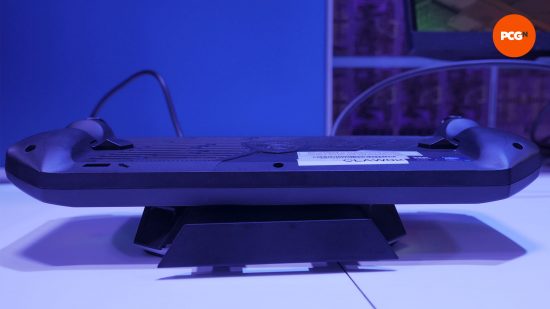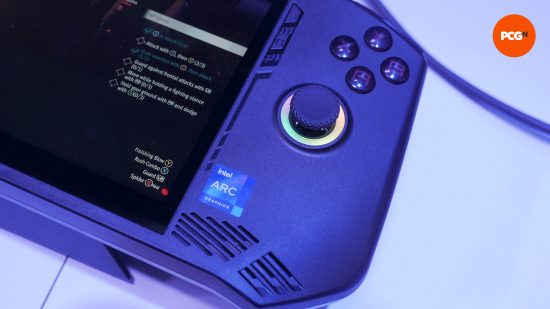MSI and Intel surprised most of the PC gaming world a couple of days ago by announcing a brand-new gaming handheld powered not by an AMD APU but by one of Intel’s one new Core Ultra chips. The MSI Claw was announced at CES 2024, where I got hands-on with the new device to see how it shapes up against the competition.
The Claw will be taking on the likes of the Steam Deck, Asus ROG Ally, and Lenovo Legion Go for the title of best gaming handheld, in what is proving to be a rapidly more competitive market. Priced at $699.99, it’s slightly cheaper than the Ally and Legion Go but pricier than the Steam Deck.

MSI Claw specs
| MSI Claw | Asus ROG Ally | Steam Deck OLED | |
| Dimensions | 294 x 117 x 21.2 mm | 280 x 111 x 32mm | 298 mm × 117 mm × 49 mm |
| Weight | 675g | 608g | 640g |
| Processor | Intel Core Ultra 155H | AMD Z1 Extreme | Custom AMD APU |
| Cores | 6P+8E+2LP-E | 8 | 4 |
| GPU cores | 8 Xe cores | 12CU | 8CU |
| TDP range | 15-45W | 10-30W | 5-15W |
| Price | $699 | $799 | $549 |
MSI Claw design
The MSI Claw sits firmly in the “Steam Deck rival” camp when it comes to gaming handhelds, with it being very similar in shape and size to that device. That’s as opposed to it offering something a bit different like with the Lenovo Legion Go, with its chunkier size and removable controllers.

Similar though it is, the Claw has some subtle differences between it and its main rivals. For a start, in terms of raw dimensions, the Claw is right in between the Ally and Steam Deck for overall size, being a few millimeters narrower than the Steam Deck and thinner than both the Ally and Steam Deck – although this figure seems to refer to just the middle thickness of the device, not including the side grips, which is a bit misleading. It is a touch heavier than it’s main competitors, though, coming in at 675g compared to 640g for the Deck and a mere 608g for the Ally.

In practice, most of these measurements make little difference. Instead, its in subtler ways that the devices feel different. For instance, the Claw has side grips that are a little fuller than the ROG Ally but not as deep as the Steam Deck. As such, it sits a little more comfortably in the hand than the Ally but not as comfortably as the Steam Deck. The compromise being that the thicker the grips, the chunkier the device overall.

Some other design subtleties include the ABXY buttons having RGB backlighting, which is quite nicely integrated. Otherwise, though, there’s little here that really sets the Claw apart from the Deck or Ally, though the rear buttons I did find easier to activate than those of the Ally.

In terms of actual styling, I think the Claw is probably the least appeal of the above three devices. The Ally has the sleek white look all sewn up while there’s a utilitarian quality to the all-black Deck. The Claw, though, is just a bit more bold with its RGB and has a few details on the plastic casing that aren’t quite so clean.
MSI Claw features
Just as the outer design of the Claw is very similar to the Deck and Ally, so are its core features, with it featuring a seemingly identical 7-inch 1080 LCD screen to the Ally and very similar button layout. The screen looks superb in person and while the Steam Deck OLED’s display does outdo both for contrast and – oddly enough for an OLED panel – moments of occasional brightness, the Claw’s screen is still very nice indeed.

Moreover, I’ve always been one of the naysayers when it comes to the Steam Deck’s screen resolution and it’s total focus on being a gaming handheld. I’ve always liked the higher screen resolution and versatility of the various Windows gaming handhelds and that’s true here too – if you’re doing anything other than gaming, the Claw will beat out the Deck at the very least.

Up on the top edge of the Claw, alongside the headphone jack, volume buttons, and microSD slot it a USB-C port that can also do Thunderbolt, allowing for easy connection to Thunderbolt hub devices for passing audio, video, and other data back and forth. In practice, this means you can easily do things like hook up a monitor, keyboard, and mouse via a single port to game on a larger screen. Not a revelation but it certainly worked well in the demo MSI had setup.
MSI Claw gaming performance
One of the key claims by MSI and Intel about the Claw is that it can offer even better performance than existing AMD-powered gaming handhelds, thanks in part to having a much higher maximu TDP of 45W, compared to 30W for the Ally and just 15W for the Stead Deck OLED.

We don’t yet have numbers to back this up but certainly the device felt like it was playing the games it was running quite smoothly and provided an entirely satisfying gaming experience. Meanwhile, testing by some other sources comparing the Claw in 30W mode and the Ally in 25W mode show they have very similar performance at 720p, averaging 50fps for the Claw and 49fps for the Ally. Based on those figures, a higher 45W seems like it would be able to unlock quite a bit of extra performance.
At the other end of the scale, a 15W minimum TDP for the Claw seems incredibly power-hungry, particularly compared to the Steam Deck, suggesting battery life in less-demanding games could be worse than those devices.
MSI Claw battery life
As just mentioned, the Claw has a much higher minimum TDP than its competitors, which would suggest a lower battery life. However, MSI is bolding claiming that the Claw will have as much as 50% higher battery life than the Ally.

What’s interesting about this is that while the Claw does actually have a much higher capacity battery – 54Wh compared to 40Wh – it’s still no where near 50% larger, so clearly there’s either some number fudging going on with comparing different TDPs or the Claw’s Intel processor does have some secret power-sipping sauce. Whatever the case, we’ll need to properly test the device to truly find out.
MSI Claw initial thoughts
The MSI Claw looks every bit like it could be a meaningful rival to the AMD-powered gaming handhelds of the world. The core look and feel of the device is spot on, initial performance seems good, and there are some bold claims being made about wider performance and battery life.
The MSI Claw price is also competitive, undercutting its most direct rivals by $100. If its performance really is as good as MSI and Intel claim, that’ll make for a very compelling combination.
For more of our thoughts on the latest mobile gaming devices, check out our best gaming handheld guide.
